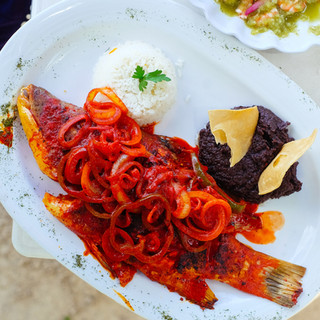Best tips to know and taste Mexican Yucatecan food?
- Info Mexico Kan Tours
- Nov 29, 2017
- 3 min read
Updated: Sep 28, 2022
The taste of Yucatan gastronomy
The Mayans possess a millenary tradition of managing the natural resources of the tropical forest and the Caribbean coastline. The creative use of this mega-diverse environment resulted in a very sophisticated gastronomy, which was later enriched by ingredients and species brought by the Spanish invaders. From this mixture is born what we know today as “Yucatecan food”, a cuisine as mestizo as its creators. More recently, influences from Middle East have been also incorporated through the Lebanese community settled in Yucatan.
Some of the most characteristic ingredients of this fusion are achiote (Bixa orellana), red onion, pepper, chili peppers and squash seeds. All of them cultivated in the Yucatan Peninsula since Pre-hispanic times. A very important inheritance from the Maya culinary culture into the Yucatecan gastronomy is the cooking system known as píib. It consists of an oven dug on the ground filled with red hot stones previously warmed on firewood, covering everything with leaves and soil and leaving the food to cook with the warmth of the stones. That’s the way to cook corn, tamales, meat and many other dishes. Píib is mostly used in special occasions, such as family gatherings or religious ceremonies.
Chicken pibil, a famous Yucatecan plate is originally a recipe cooked on the underground oven and seasoned with achiote and bitter orange juice. Achiote (kiwi’ in Mayan language) is a red seed with a mild spicy flavor widely used in the Yucatecan gastronomy to color and season many dishes.
Tikin xiik’ is very well known too, it’s a whole fish wrapped with banana leaves, cooked on the grill and covered with a gravy made of achiote, red onions, xkatik peppers and oregano. A true delicatessen!
Lime soup is another original and exquisite dish. It’s a seasoned chicken broth with lime juice. But a special lime is used, it’s a very aromatic citric that isn’t as sweet as the orange or as acid as the lemon. You have to try it!
We just couldn’t miss the snacks, such as salbutes and panuchos, which are basically hand-made corn tortillas with beans, lettuce, radish, chicken and hot sauce. Kibis are also a Yucatecan snack, but with a Lebanese origin, made out of wheat flour and ground beef.
We invite you to experience these unique and succulent flavors by booking any of our tours in which you will have the opportunity to taste exquisite Yucatecan dishes.
Mayan gastronomy: a farmer’s diet and food of the gods Besides the Yucatecan mestizo cuisine of which we spoke in our last article, we have to say that the distinctive Maya farmer food is still alive. This diet is very similar to the one their ancestors had in the Pre-hispanic Mexico, based on the products of the family garden and the milpa (corn plantation). The most important elements are corn, beans, squash, yucca, sweet potato, tomato and chili peppers. All of these ingredients, as well as many others, such as cacao, peanuts and vanilla are now an important part of very different gastronomies around the world, but have their origin on the Mesoamerican area: central and southern Mexico and in the north of Central America.
Nowadays, the Mayan cuisine is very broad. Even though the daily diet is simple, it’s very well spiced and it always includes tortillas, hot sauce and is cooked on firewood. Dishes made for social events and ceremonies are complex recipes of gourmet cuisine.
Take Sak kool, for instance, is a white thick broth, the Maya version of mole (a very famous Mexican dish made with more than 20 ingredients). They all come from local production, but some mixed versions include raisins, wheat flour, capers and saffron. In ancient times, before the arrival of pigs and chickens, the meat for this recipe would have been taken from the ocellated turkey (Meleagris ocellata), the lowland paca (Cuniculuspaca), the collared peccary (Pecari tajacu) or maybe from the dogs the Mayan raised to be sacrificed and eaten on religious rituals.
Relleno negro, which could be translated as black stuffing, is another variant of a Maya style mole. Relleno negro is a soup that is blackened because of the burnt chili peppers it contains. It’s so black and shiny that you can look at your own reflection while eating it. It antiqueness is undeniable because it is mentioned in the mythology as the mirror the divine twins, sons of the god of the corn, used to discover the hideout of the lords of the death.
If you want to live the gastronomical experience of tasting this antique flavors, we invite you to book any of our tours, in which you’ll be able to enjoy the dishes of the real Mayan cuisine.
#mexicangastronmy #Tulumgastronomytours #mexicofood #yucatanfoo #yucatangastronmytours #mexicogastronmyexperience #yucatangastronmyexperiences #tulumgastronmy #tulumfood #bestgastronomymexico #bestyucatangastronomy #bestgastronmytoursmexico #bestyucatangastronmytour #bestTulumgastronomytours #besttulumfoodtours #besttulumfoodexperiences

























Comments